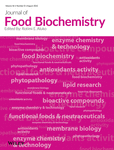Antioxidant activity of delphinidin and pelargonidin: Theory and practice
Funding information
This project was funded by the National Natural Science Funds of China (Grant 21964012) and Jiangxi double thousand plan (jxsp 2019201077)
Abstract
The quantum chemical density functional theory and in vitro chemical-based antioxidant assays were used to research the reaction mechanism of delphinidin/pelargonidin with free radicals including superoxide anion radicals (O2−∙) and hydroperoxide radicals (OOH∙). The geometric configuration, bond dissociation energy, PCM (polarizable continuum model) solvent model reaction enthalpy changes were studied to explain the transition states, and the reaction enthalpy change value was calculated to determine the active site. From the results of spatial configuration, delphinidin showed a stronger conjugation effect than that of pelargonidin. The dihedral angle between the three rings of delphinidin was almost 180°, and the angle between the B and C rings was only −2.81868°. Both coplanar and antioxidant activity of delphinidin was better than pelargonidin. The consequences of reaction enthalpy change in PCM were consistent with the bond dissociation energy. The phenolic hydroxyl bond dissociation energy of delphinidin was slightly smaller than that of pelargonidin. Moreover, the C4' site of delphinidin and the C3 site of pelargonidin were the active sites for scavenging free radicals. The free radical scavenging ability of delphinidin was marginally higher than that of pelargonidin. On the other hand, in vitro antioxidant results proved the scavenging ability of delphinidin and pelargonidin on superoxide anions, DPPH, and ABTS∙+ free radicals. It was shown that the chemical-based antioxidant activity was consistent with the theoretical calculation results, with delphinidin showing greater antioxidant activity. These results could explain the antioxidant mechanism of delphinidin/pelargonidin in scavenging free radicals from chemical reactions.
Practical applications
This manuscript explained the antioxidant mechanism of delphinidin/pelargonidin in scavenging free radicals through the analysis of the geometric configuration of delphinidin/pelargonidin and the theoretical calculation of the reaction transition state. It could also speculate on the possible reaction sites, and provide a basis for judging how to efficiently select antioxidants with great antioxidant activity.
CONFLICT OF INTEREST
The authors declared that they have no conflict of interest.
Open Research
DATA AVAILABILITY STATEMENT
All data generated or analysed during this study are included in this published article.




